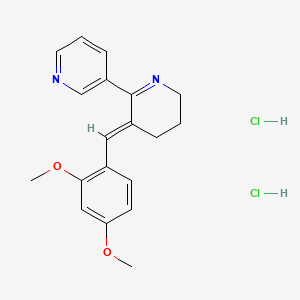



1. 3-(2,4-dimethoxybenzylidene)anabaseine
2. Dmxba
3. Gts 21
4. Gts-21
1. 156223-05-1
2. Gts 21 Dihydrochloride
3. Dmxba
4. Gts-21 (dihydrochloride)
5. Dmxb-anabaseine
6. 3-[(5e)-5-[(2,4-dimethoxyphenyl)methylidene]-3,4-dihydro-2h-pyridin-6-yl]pyridine;dihydrochloride
7. Dmbx-a
8. Dmbx-anabaseine
9. (e)-3-(2,4-dimethoxybenzylidene)-3,4,5,6-tetrahydro-2,3'-bipyridine Dihydrochloride
10. 3-(2,4-dimethoxybenzylidene)-3,4,5,6-tetrahydro-2,3'-bipyridine Dihydrochloride
11. 156743-66-7
12. Gts-21 2hcl
13. Gts 21
14. Dmxb
15. Schembl2561893
16. Schembl12274790
17. Ex-a5724
18. Hy-14564a
19. Akos037515500
20. Cs-5486
21. (e)-3-((2,4-dimethoxyphenyl)methylene)-3,4,5,6-tetrahydro-2,3'-bipyridine Dihydrochloride
22. 2,3'-bipyridine, 3-((2,4-dimethoxyphenyl)methylene)-3,4,5,6-tetrahydro-, Dihydrochloride, (e)-
23. Ac-31954
24. Gts-21, >=97% (hplc)
25. 3-(2,4-dimethoxybenzylidene)anabaseine Dihydrochloride
26. 3-(2,4-dimethoxybenzylidene)-anabaseine Dihydrochloride
27. 3-(3-(2,4-dimethoxybenzyl)-3,4,5,6-tetrahydropyridin-2-yl)pyridine Dihydrochloride
28. (e)-3-(3-(2,4-dimethoxybenzylidene)-3,4,5,6-tetrahydropyridin-2-yl)pyridine Dihydrochloride
| Molecular Weight | 381.3 g/mol |
|---|---|
| Molecular Formula | C19H22Cl2N2O2 |
| Hydrogen Bond Donor Count | 2 |
| Hydrogen Bond Acceptor Count | 4 |
| Rotatable Bond Count | 4 |
| Exact Mass | 380.1058333 g/mol |
| Monoisotopic Mass | 380.1058333 g/mol |
| Topological Polar Surface Area | 43.7 Ų |
| Heavy Atom Count | 25 |
| Formal Charge | 0 |
| Complexity | 447 |
| Isotope Atom Count | 0 |
| Defined Atom Stereocenter Count | 0 |
| Undefined Atom Stereocenter Count | 0 |
| Defined Bond Stereocenter Count | 1 |
| Undefined Bond Stereocenter Count | 0 |
| Covalently Bonded Unit Count | 3 |
Nicotinic Agonists
Drugs that bind to and activate nicotinic cholinergic receptors (RECEPTORS, NICOTINIC). Nicotinic agonists act at postganglionic nicotinic receptors, at neuroeffector junctions in the peripheral nervous system, and at nicotinic receptors in the central nervous system. Agents that function as neuromuscular depolarizing blocking agents are included here because they activate nicotinic receptors, although they are used clinically to block nicotinic transmission. (See all compounds classified as Nicotinic Agonists.)
